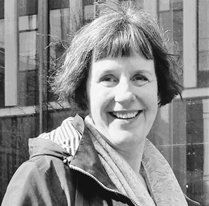
In the final post of our five-part conversation with Anthony Skerik and Professor Sabine Rolle, they zoom out to examine the larger systems shaping interdisciplinary education. From curriculum transformation to portfolio review, Edinburgh Futures Institute (EFI) operates in a fast-changing institutional environment. Sabine offers insight into how the University can balance innovation with reflection—and what she hopes to see in the future of interdisciplinary learning. This post belongs to the ‘Navigating complexity through interdisciplinary teaching and learning‘ Hot Topic series.
The Conversation
Anthony: So, looking ahead, thinking about the future of interdisciplinary education—what do you think needs to happen at an institutional or cultural level for it to move from the margins to something more mainstream in higher education?
Sabine: That’s a really good question, and I want to start by gently reframing it. The way you’ve phrased it assumes that interdisciplinarity should become mainstream, perhaps scaled up significantly. And while there’s some truth in that—I’d certainly like to see more of it—I don’t think interdisciplinarity should be imposed as a universal model.
In my view, interdisciplinary education is one essential part of a healthy academic ecosystem. It shouldn’t replace deep disciplinary inquiry, which remains critical. Instead, what I hope for is a future where interdisciplinarity is broadly acknowledged as valuable and necessary—just one of the important approaches higher education can offer.
I think as more graduates emerge from interdisciplinary programmes, and as their successes become visible, it will become easier for future students to choose these kinds of degrees without the same level of anxiety. Hopefully, it will no longer require quite as much bravery. Over time, with real examples and proof of concept, interdisciplinarity can be seen as a valid and effective educational path—not just at the level of a course or module, but across entire degree programmes.
We’re not starting from zero here. There’s already a tradition of interdisciplinary or liberal arts programmes, particularly in the U.S., but also globally. While those models differ from what we do at EFI, they demonstrate that interdisciplinary education can lead to meaningful employment, postgraduate study, and other successful outcomes. So part of making interdisciplinarity more “mainstream” is simply building on that tradition and helping it gain visibility, especially in places like the UK where the terminology or models might be less familiar.
To get there, I think we need broader public and institutional conversations about the value of this kind of education. That includes visibility in policy discussions, education journalism, and public discourse. If we can help parents, students, teachers, and employers understand what these degrees offer, we can ease some of the uncertainty that comes with choosing a new kind of academic path.
Anthony: That makes a lot of sense, especially when you consider the longer-term vision. I’ve also heard some staff members express concern that we might be moving too quickly—that the university is rolling out new interdisciplinary models without fully learning from what’s already been tried, especially at EFI. Do you think that’s a fair critique?
Sabine: I understand that concern, and it’s a valid question. But I don’t actually think we’re moving too fast, and here’s why: the models we’re using haven’t come out of nowhere. Interdisciplinary education has been developing here at Edinburgh and at other institutions for many years. Programmes like Interdisciplinary Futures are built on a foundation of long standing expertise and experience.
When we designed those challenge courses, for example, we brought together colleagues who have deep experience in interdisciplinary teaching. These weren’t ad hoc committees—they were groups of people who have been running interdisciplinary courses and developing new models of teaching for a long time. That’s the foundation we’re building on.
That said, I also believe in iterative design. No matter how well-prepared you are or how robust your planning, you still have to be ready to adapt. New initiatives—especially those aiming to challenge long-standing structures—need to evolve as they’re implemented. You can’t expect everything to work perfectly from the outset, and frankly, you shouldn’t. Just as we expect our students to be adaptable, we as educators and institutions need to model that same adaptability.
So yes, we rely on the existing body of evidence, but we also accept that we’ll need to make adjustments as we go. That’s not a flaw in the process; that’s part of how innovation works. It’s how research works, too: you start with a hypothesis grounded in knowledge, and then you test it, refine it, improve it.
Anthony: That leads really well into my final question. I’m curious about your personal vision for Interdisciplinary Futures over the next five to ten years. How has that vision evolved now that the programme has been running for a couple of years?
Sabine: Interestingly, my overall vision hasn’t changed, at least, not yet. I reflect on it constantly, and I’ve revisited it many times as the programme has developed. So far, I’ve always come back to the same conclusion: that our vision is both valid and essential.
I still strongly believe in the need for a programme like this, and I’m convinced that it responds to something real and pressing in the world of education and work. In fact, if anything, I think the world we’re preparing students for is only going to make interdisciplinary thinking more necessary—not less.
That said, what has evolved is my understanding of how we implement that vision. For example, I’ve come to see even more clearly how important it is to support students in the early stages of the programme—especially when they’re grappling with questions like, “Is this a real degree?” or “Where will this take me?” That’s an area where we need to improve: in communicating not just what the programme is, but also why it matters, and how it connects to the futures our students are preparing for.
So while the vision itself remains intact, our methods—our communication, our support structures, the way we help students navigate the uncertainty—those are areas where we’re constantly adapting. It’s an iterative process. But the core vision? I still stand by it. And I hope that in the coming years, it will continue to attract curious, open-minded students who are ready to challenge boundaries and explore new possibilities.
Anthony: I think that iterative mindset really captures the spirit of the programme itself. It’s reassuring to hear that the vision is still holding strong, especially in a time where education is under so much pressure to change. I’ve really appreciated this conversation. It’s been eye-opening to hear how much intentionality and reflection is going into Interdisciplinary Futures behind the scenes. Thank you so much for taking the time to speak with me, and I’m excited to see how the programme continues to grow and evolve in the years to come.
Wrapping it all up
Across these five posts, my conversation with Professor Sabine Rolle has uncovered the ambitions and tensions at the heart of interdisciplinary education. From redefining what counts as a “real” degree to navigating institutional silos and preparing students for a fast-changing world, it’s clear that this work is both visionary and deeply grounded in practical realities. The Interdisciplinary Futures programme isn’t just an academic experiment-it’s a response to the complexity of our time.
As universities face pressure to adapt, EFI’s model shows that meaningful transformation is possible when we lead with honesty, collaboration, and a commitment to long-term change. Interdisciplinary education may not be a universal fix, but it offers a powerful way to prepare students for futures that resist simple solutions.
 Anthony Skerik
Anthony Skerik
Anthony Skerik is a student at the University of Edinburgh and a member of the inaugural Interdisciplinary Futures class of 2027. His work explores how interdisciplinary thinking can be applied to real-world challenges, with a particular interest in conflict, innovation, and co-creation. He has held multiple positions within the University’s Information Services Group (ISG), supporting projects that bridge technology, communication, and education. As a co-editor of the Navigating Complexity: Preparing for the Future through Interdisciplinary Education blog series, he is committed to highlighting student perspectives and documenting the evolving landscape of interdisciplinary learning.
 Sabine Rolle
Sabine Rolle
Sabine Rolle is based in the Department of European Languages and Cultures (LLC) but currently does all her teaching through EFI, on the MA (Hons) Interdisciplinary Futures and the electives offered by EFI to students from across the university. Her strong interest in interdisciplinary education is also put to use in the role she plays leading on the development of cross-School Challenge Courses, as part of the Curriculum Transformation Programme and the implementation of the Learning and Teaching Strategy 2030.


